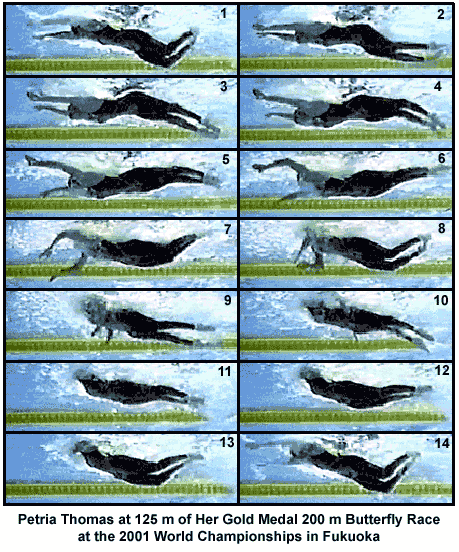HOW CHAMPIONS DO IT
Researched, produced, and prepared by Brent S. Rushall,
Ph.D., R.Psy.

PETRIA THOMAS AT 125 m OF HER GOLD MEDAL 200 m BUTTERFLY RACE AT THE 2001 WORLD CHAMPIONSHIPS IN FUKUOKA
Each frame is .1 seconds apart. Petria Thomas' time for the 200m race was 2:06.73.
This stroke analysis includes a moving sequence in real time, a moving sequence where each frame is displayed for .5 of a second, and still frames.
The following image sequence is in real time. It will play through 10 times and then stop. To repeat the sequence, click the browser's "refresh" or "reload" button.

The following image sequence shows each frame for half a second. It will play through 10 times and then stop. To repeat the sequence, click the browser's "refresh" or "reload" button.

At the end of the following narrative, each frame is illustrated in detail in a sequential collage.
Notable Features
Frame #1: The hands are entering the water in a "scissors-in" manner. The hips have dropped and the knees drop even more to facilitate a very substantial kick.
Frame #2: The hands have entered and come together. Unfortunately, the hands are not in a position from which propulsive forces can be exerted. This unnecessary action requires the hands to stop and change direction so they can proceed to a position where propulsion can be developed. The legs kick and elevate the hips. Since the body rotates around the center of buoyancy, the head and shoulders sink as the hips rise.
Frame #3: The head and shoulders have sunk, the lower back is hyperextended, and the legs are at an angle to the line of progression. It is possible that this is a "wave action", a misguided concept of swimming that is not well accommodated at all by humans when arms are involved in swimming. It is also possible that this exaggerated movement of the body and the water it displaces, as opposed to accelerating water along the body, occurs to allow time for the hands to be repositioned to a point where they can begin to be effective. It is not possible to discern whether the hands perform time-consuming unnecessary movements to accommodate the kick-hip movements, or vice versa. The arms perform a classic, but weak, outward sculling action. A small vertical force component is developed that could slightly reduce the amount of "dive" of the head and shoulders.
Frame #4: The arms continue to spread. The hips start to sink down reducing the non-streamlined angles displayed in Frame #3.
Frame #5: The arms are spread and begin to bend at the elbow. However, the hands remain pitched "outward" reducing potential force generation. The head begins to rise and the face profile is positioned forward. As a reaction to the movement, the hips sink.
Frame #6: The arms bend at the elbows, only slight medial rotation of the upper arms occurs, some abduction of the upper arms develops force, but most of the force developed is vertical causing the head and shoulders to rise and the hips to sink further. [The large amount of water that is moved by vertical hip and leg movements requires energy, and that is energy that could be used for propulsion.]
Frame #7: The arms produce considerable propulsion, although some vertical force component still exits (possibly to support the elevated head and shoulders). The source of propulsion is abduction of the upper arms and the propelling surface in this frame is virtually all of the arm, included the upper arm surface. The hips continue to drop further disrupting streamline.
Frame #8: Arm propulsion continues and is now powered by adduction of the upper arms. The head and shoulders continue to rise while the knees drop down due to flexion at the hip joint. This action increases drag resistance considerably because it increases the frontal area of the swimmer's profile.
Frame #9: Arm propulsion and the area of the propelling surface diminish as the elbows extend. The legs kick to counterbalance vertical forces being developed by the exiting arms and to stop the hips sinking further.
Frame #10: Arm propulsion concludes with the initiation of a "round-out" action to conserve momentum after partial extension at the elbows. The legs kick to fully support the elevated head and shoulders.
Frame #11: The recovery of the arms proceeds. The swimmer is now propelled by inertia created during the propulsive phase. As the arms recover, they produce a downward force that causes the swimmer's shoulders, hips, and legs to sink. An increase in hyperextension of the thoracic region of the spine allows the head to remain out of the water despite the rest of the body and legs sinking.
Frame #12 through #14: The swimmer sinks and prepares to kick to repeat the cycle that was described and initiated in Frame #1.
Petria Thomas displays movements in her butterfly stroke that are of questionable effect. The scope of movement of the hips and legs in kicking (Frame #1 through #6) is unnecessarily exaggerated and energy consuming. The entry of the hands and their lengthy repositioning also interfere with optimizing the propulsion to inertial lag ratio. These factors should be compared to those shown in the analysis of Mary T. Meagher, who more than 20 years ago and at a very young age, swam faster than Petria Thomas.
One further complication with Petria Thomas' stroke is that she breathes every stroke. That results in an inertial lag every stroke (it is possible that the inertial lag might not occur when the head is held down) and the greatest accumulation of loss of streamline (which occurs when she breathes). Although the breathing pattern is a personal choice, breathing every stroke in butterfly incurs considerable cost in energy expenditure and loss of time. All 200-m butterfly swimmers should be encouraged to train and race with a breathing movement on every other stroke.

Return to Table of Contents for this section.






